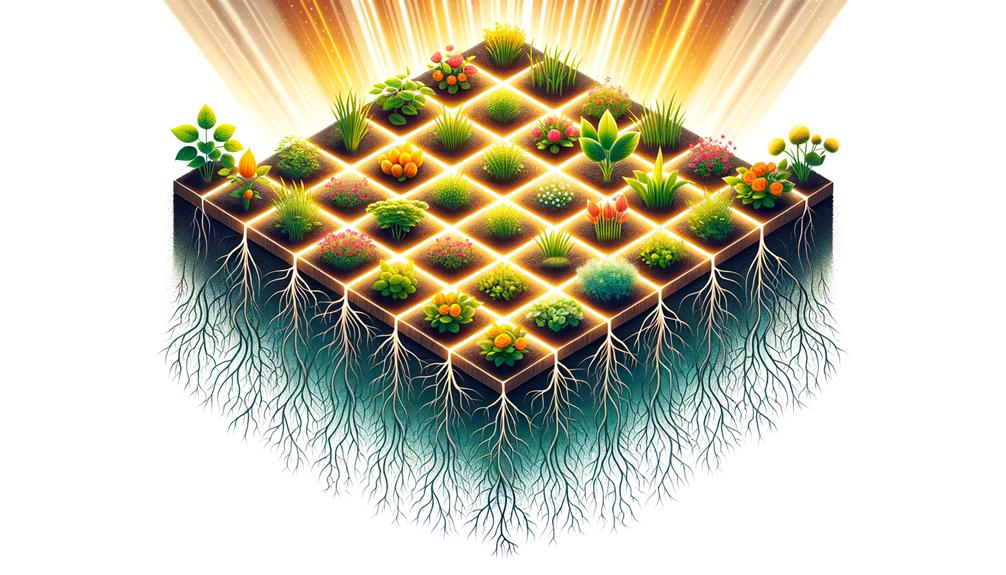Did you know that by optimizing your square foot garden spacing, you can increase your yield by up to 50% compared to traditional row gardening? It’s true, and it’s a game-changer.
So let’s look at the 7 things you can do to get the most out of your garden space.
1. Understanding Plant Spacing
To optimize your garden’s yield, it’s crucial to understand that each plant has specific spacing requirements, determined by its root system and canopy spread, to ensure adequate access to sunlight, water, and nutrients.
Implementing grid patterns in your square foot garden maximizes space and promotes healthy plant growth. This method involves dividing your garden space into equal squares, each tailored to accommodate the spacing needs of different plants. For instance, larger vegetables might occupy an entire square, while smaller ones can be planted in groups within a single square.
Seed depth also plays a pivotal role in plant spacing. Planting seeds at the correct depth ensures they’ve the right conditions for germination and root development. Too shallow, and they may not germinate; too deep, and they mightn’t reach the surface. Each plant species requires a specific seed depth, usually noted on the seed packet, which must be adhered to for optimal growth.
2. Utilizing Vertical Space
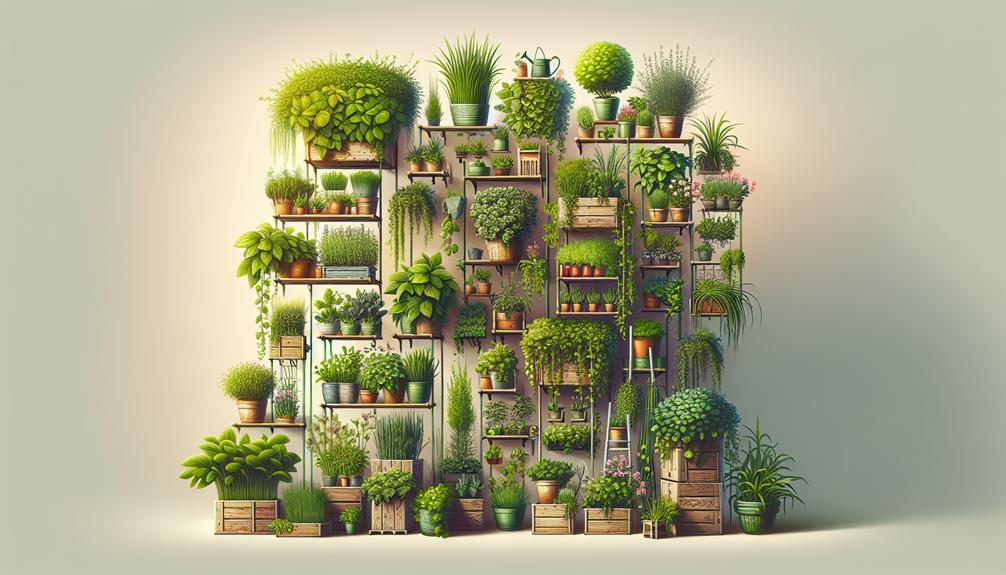
While understanding plant spacing across the horizontal plane is crucial for maximizing yield, don’t overlook the benefits that leveraging vertical space can offer to your square foot garden’s productivity and health. Utilizing vertical space not only enhances air circulation around plants, reducing the risk of fungal diseases, but also maximizes sunlight exposure, crucial for photosynthesis.
Selecting appropriate trellis materials is vital for successful vertical gardening. Lightweight options such as bamboo, wooden stakes, or PVC pipes are excellent choices. They’re durable, easy to install, and provide sturdy support for climbing plants. Moreover, integrating climbing aids like netting, strings, or wire meshes can guide plant growth upwards efficiently. These materials should be installed early in the plant’s growth cycle to ensure smooth vine development and reduce stress on the plant.
When planning your vertical garden, consider the mature size of your plants. This foresight prevents overcrowding and ensures each plant receives adequate sunlight and nutrients. Additionally, strategically placing taller crops on the north side of your garden prevents them from casting shadows on shorter plants, ensuring even light distribution.
Incorporating vertical space in your square foot garden enhances yield, improves plant health, and optimizes your gardening space. With the right trellis materials and climbing aids, you can create a thriving, productive garden in a compact area.
3. Incorporating Companion Planting
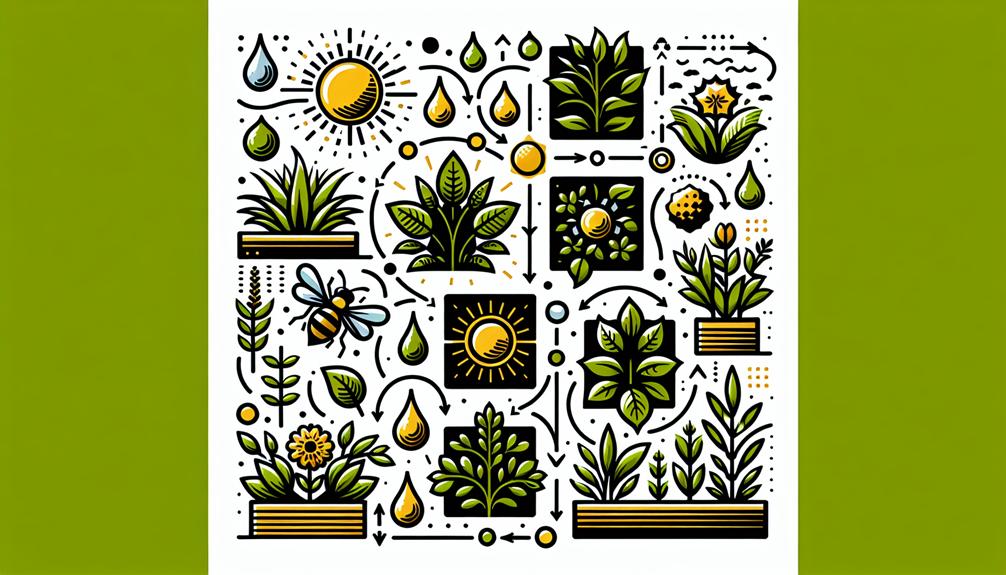
Incorporating companion planting into your square foot garden significantly improves plant health and yield by fostering beneficial interactions between different species. This method leverages the natural relationships between plants to enhance pest control, pollinator attraction, and nutrient uptake, resulting in a more resilient and productive garden.
Here’s how you can integrate companion planting effectively:
- Select Complementary Pairs: Choose plant pairs that offer mutual benefits. For instance, marigolds repel pests that might target your tomatoes, while basil improves tomato flavor and attracts beneficial insects. This not only maximizes your space but also reduces the need for chemical pest control.
- Focus on Pollinator-Friendly Combinations: Incorporate flowers and herbs known for pollinator attraction alongside your veggies. Lavender, borage, and zinnias, for example, draw pollinators essential for the pollination of many vegetable crops, enhancing fruit set and yield.
- Utilize Natural Pest Deterrents: Certain plants, such as garlic and chives, naturally repel common garden pests, including aphids and spider mites. Positioning these around susceptible crops can significantly reduce pest populations without harming beneficial insects.
4. Managing Soil Fertility

After exploring how companion planting can boost your garden’s health and productivity, it’s crucial to address managing soil fertility to ensure your plants receive the essential nutrients they need for optimal growth.
A key step in this process is soil testing, which provides a detailed analysis of your garden’s soil composition. By understanding the specific nutrient levels and pH balance, you can tailor your fertilization strategy to meet your plants’ needs.
Soil testing kits are readily available at garden centers, allowing you to collect soil samples and either test them at home or send them off to a laboratory for a more comprehensive analysis. The results will guide you in selecting the right fertilizer types and application rates.
There are various fertilizer types to consider, including organic options like compost and manure, which slowly release nutrients and improve soil structure, and synthetic fertilizers, which offer a quick nutrient boost but require careful application to avoid over-fertilization.
5. Choosing the Right Plants
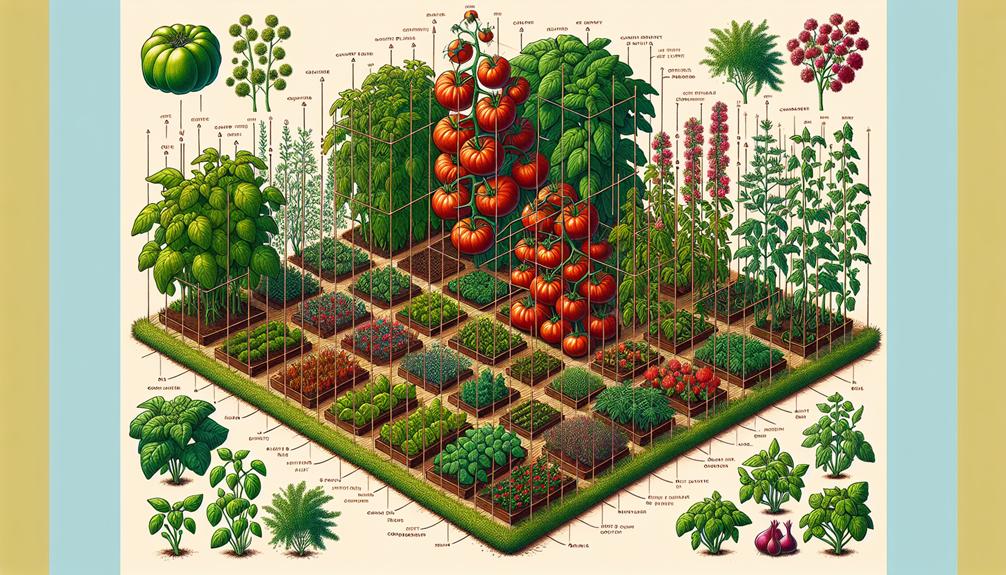
You need to carefully consider which vegetables to plant together in your square foot garden. Not all plants are compatible due to varying nutrient needs and potential for cross-contamination.
Evaluating plant growth habits is essential to maximize space and ensure healthy growth. For example, differentiating between vine and bush types can help you plan the layout of your garden more effectively.
Additionally, choosing plants that are well-suited to your garden’s seasonal climate is crucial. This can significantly impact your garden’s productivity and sustainability.
Selecting Compatible Vegetables
Selecting the right plants for your square foot garden involves understanding each vegetable’s growth requirements and compatibility to ensure optimal space utilization and yield. It’s not just about fitting as many plants as you can; it’s about choosing vegetables that can thrive together, enhancing both crop rotation and pest control strategies.
Here’s how you can make your garden more productive:
- Consider Companion Planting: Some plants, when grown together, naturally repel pests and improve soil health, reducing the need for chemical interventions.
- Plan for Crop Rotation: Rotating crops in your square foot garden helps prevent soil depletion and disrupts the lifecycle of common pests.
- Understand Growth Patterns: Select plants with similar light and water needs to ensure one doesn’t overshadow or outcompete the other, maximizing your garden’s yield.
Plant Growth Habit Considerations
Understanding each vegetable’s compatibility is crucial, but it’s equally important to consider the growth habits of the plants you choose for your square foot garden.
The growth habit of each plant, affected by climatic influences, dictates not only the space required but also impacts pest management strategies.
For instance, vining plants like cucumbers need vertical space to climb, optimizing your garden’s footprint while enhancing air circulation, a key factor in reducing pest infestations.
Similarly, understanding the shade tolerance of lower-growing plants can help in planning their placement under or beside taller, sun-loving species.
This strategic placement ensures that all plants receive the appropriate amount of sunlight, further influenced by seasonal climatic variations, ensuring that your garden remains productive and healthy.
Seasonal Plant Choices
Choosing the right plants for your square foot garden requires a keen understanding of how different species adapt to the changing seasons, affecting their growth cycle and yield. It’s not just about what you want to grow, but what can grow successfully in your garden’s microclimate.
Here are three key considerations:
- Climate adaptation: Select plants that are known to thrive in your region’s seasonal temperature and humidity fluctuations.
- Pest resistance: Opt for varieties with built-in resistance to common pests. This reduces the need for chemical interventions.
- Harvest season: Balance your garden with plants that mature at different times, ensuring a continuous harvest throughout the growing season.
6. Timing Your Plantings
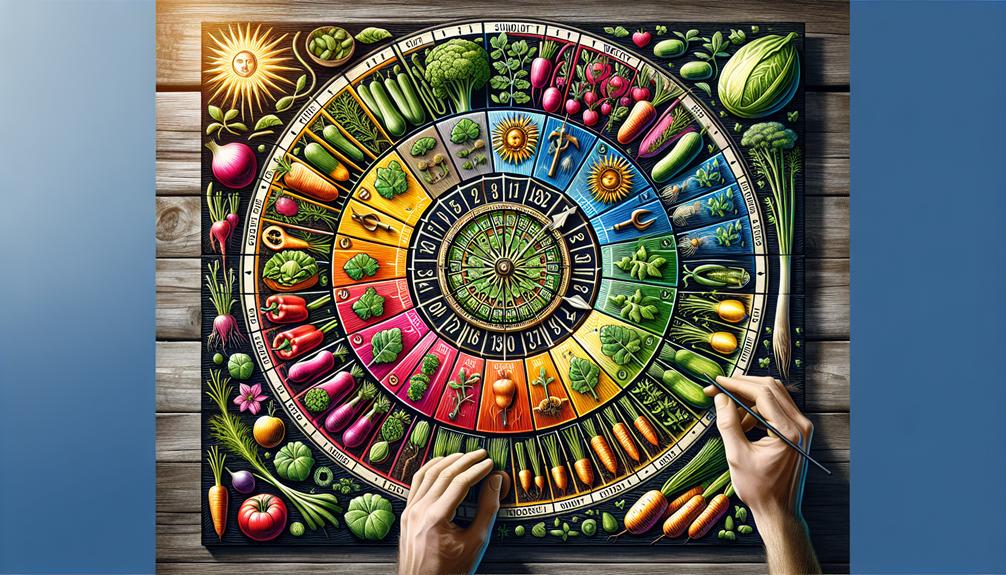
To maximize your garden’s yield, it’s crucial to time your plantings with the specific growth cycles and environmental needs of each plant variety. Understanding climate adaptation and seed viability plays a pivotal role in this. Plants have adapted over generations to thrive in specific conditions, and syncing your planting schedule to these conditions ensures optimal growth. For instance, cool-season crops like spinach and peas should be planted early when they can fully benefit from lower temperatures before the heat of summer stresses them.
Moreover, seed viability—how long a seed remains capable of germination—dictates the best planting times. Most seeds have a shelf life, beyond which their germination rates drop. To ensure your garden thrives, use fresh seeds or those stored correctly to maintain their viability.
Scientifically, timing also involves understanding the plant’s lifecycle. Annuals, perennials, and biennials each have unique timelines. Annuals complete their lifecycle in one year, requiring replanting each season, while perennials return for multiple seasons. Biennials, on the other hand, need two years to complete their lifecycle. By aligning your planting schedule with these cycles, you’ll ensure your square foot garden is both productive and efficient.
7. Watering Techniques

Efficient watering strategies are essential in maximizing the health and yield of your square foot garden. This requires an understanding of each plant’s unique hydration needs. To ensure your garden thrives, integrate scientific principles with practical approaches for optimal water use.
- Drip Irrigation: This system delivers water directly to the base of each plant, minimizing evaporation and ensuring deep root watering. By using a drip irrigation system, you’re not only conserving water but also targeting the water exactly where it’s needed most. It’s a precise method that can be adjusted as plants grow and their water needs change.
- Water Conservation Techniques: Mulching around your plants helps retain soil moisture, reducing the frequency of watering. Additionally, collecting rainwater in barrels can provide an eco-friendly water source for your garden. These techniques not only save water but also promote a healthier plant root environment.
- Understanding Plant Needs: Become familiar with the water requirements of each type of plant in your square foot garden. Some vegetables may need more frequent watering than others. Adjust your watering schedule based on rainfall, temperature, and the specific needs of your plants to avoid over or under-watering.
Incorporating these techniques into your gardening routine will lead to a more productive and sustainable square foot garden.

